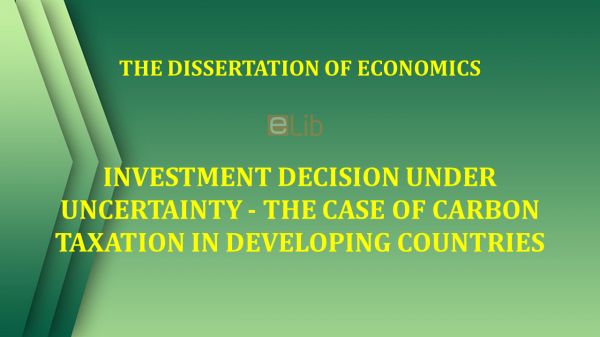Th.D: Investment decision under uncertainty - The case of carbon taxation in developing countries
The thesis "Investment decision under uncertainty - The case of carbon taxation in developing countries" is completed with the objective of making the managerial and policy implications will be recommended for better FDI project while minimizing environmental world as well as raising the quality of technology and labor in these projects.
Mục lục nội dung

Th.D: Investment decision under uncertainty - The case of carbon taxation in developing countries
1. Overview of research
1.1 Research setting and motivations
In Vietnam, there are quite a few researches on the factors affecting FDI inflows in general. The typical researches should be referred to Nguyen Thi Lien Hoa & Bui Bich Phuong (2014); Le Van Thang & Nguyen Luu Bao Doan (2017). Both studies used the quantitative approach to estimate the relationship of factors affecting FDI inflows into Vietnam such as GDP, foreign exchange reserves, degree of infrastructure development, labor costs, national trade openness, labor quality, level of urbanization, and concentration of domestic enterprises. These researches are quite useful for designing of macro policies that attract FDI.
As the survey of Vietnam’s related academic researches, there are no researches on investment decisions of foreign firms in irreversible projects under uncertainty related to carbon taxation. In the academic world, researches about the effects of carbon taxation related uncertainties have been developed in the form of single case study only such as coal fired power plant projects. Therefore, the generalization capability of these research results for policy making is not so high. We could see that the study of foreign investment decisions on irreversible FDI projects in Vietnam under uncertainty is necessary and it would bring many benefits as listed below.
1.2 Research targets
Based on reviewing results of theoretical and empirical researches, the research gaps will be identified for the thesis’s research concentration. The important part of thesis is to build the research model in mathematical form to fill the identified research gaps. The thesis will focus on the effects of carbon taxation related uncertainties on the investment decision behavior of investors from developed countries (carbon taxed countries), investing in irreversible projects in developing countries (non-carbon taxed countries) which are similar to Vietnam. Through the development of mathematical models and calculations, investment decision and the selection of capital/technology and labor levels in irreversible FDI projects in Vietnam will be examined under the carbon tax related uncertainties.
1.3 Research objectives
The main objective of the thesis is the firm’s investment decision in the irreversible project under the uncertainties associated with the carbon taxation. This type of taxes is commonly imposed in some developed countries aiming at greener and sustainable development which would be applied in Vietnam in the near future. The impacts of these carbon tax related uncertainties on the investment decision behavior of foreign firms will be examined, especially the optimum level of capital / technology and labor choices that the foreign investors can decide to choose in their investment projects in Vietnam.
1.4 Scope of research
The scope of the research is large fixed assets of foreign companies in Vietnam that cause carbon emissions and therefore there are potential uncertainty/carbon tax risks in these projects. This type of project is referred in academic community as irreversible investment projects by (McDonald & Siegel, 1986). In practice, these projects are very large value ones producing/supplying basic commodities of the economy or infrastructure projects in transportation, telecommunications, energy, oil and gas exploitation, power plants, oil refinery, iron and steel plants, chemicals production, real estates. Investors of these projects are often large industrial companies from developed countries (MNEs / MNCs). Since the phenomenon of carbon tax avoidance mainly from developed countries where the carbon taxation is already applied or about to apply, to non-carbon taxation developing countries, therefore, this study in Vietnam context can be generalized to other developing countries.
1.5 Methodology
The thesis has applied quantitative approach by mathematical modeling and simulation techniques using reasonable assumption data and collected data in practices if available. The choice of research method is considered on the nature of the research nature, the relevant studies and the availability of actual data as follows.
1.6 Expected outcomes of the thesis
The thesis is expected to contribute to academic knowledge, research methods and practical application in project appraisal. In terms of academic knowledge, the thesis will provide a theoretical framework and empirical evidences of uncertainties and investment decision into irreversible project in Chapter 2 in which uncertainties of carbon taxation will be given priority. In addition, the results of the model development using mathematical techniques in the thesis are expected to provide new theoretical discoveries: carbon taxation is likely to limit low-tech investors. Consequently, if the carbon tax is used as an adjustment tool, the government may develop carbon tax related policies to increase the quality level of FDI projects. This theoretical discovery is a clearly novelty of the thesis.
2. Content
2.1 Overview of Research
Research setting and motivations
Research targets and research questions
Research objectives and scope of research
Methodology
Expected outcomes of the thesis
Structure of the thesis
2.2 Theoretical framework and empirical evidence
The firm and investment operation
Foreign direct investment and its impact factors
Irreversible project
Investment decision under uncertainties
Investment decisions under carbon taxation uncertainties
Research gaps
2.3 Research Method
Selection of research methods
Research model
Model development based risk response of investors
Optimization techniques by maths
Simulation of research results
Simulated data
2.4 Investment decisions under uncertainties of carbon taxation
The Basic model
Modeling the cases of carbon and non-carbon taxation
The ratio of capital/labor in case of carbon and non-carbon taxation
Modeling the case of uncertain timing in application of carbon taxation
Modeling the case of investors with different technology level
Numerical results of simulation from the case of carbon and non-carbon taxation
2.5 Policy and managerial implications
General conclusions
Policy and managerial implications
Research limitations and recommendation for further research directions
3. Conclusions
Under different modeling cases involving uncertainties of carbon taxation affecting investor profitability, the results of algorithmic modeling and calculations show the interesting implication as follows.
Firstly, when comparing two cases with and without carbon taxation, it is clear that the application of carbon taxation will reduce the investor's optimal capital stock and labor level (Theory 1). However, the optimal capital/labor ratio in the case of carbon tax is higher than that of the case without carbon tax, suggesting that carbon taxation is effective to increase technology level in their project (Theory 2).
Secondly, when investors consider investing in a non-carbon taxed country, they will concern the uncertainties of carbon taxation such as: when will the government apply carbon tax? For the investor who is not risk taker, they will determine the worst case: the government will apply carbon taxation as soon as on the first year of their project life cycle.Therefore, they will choose low optimal capital/ technology and labor levels which are equal to case of carbon tax applied (Theory 3).
Thirdly, when the government has applied carbon taxation that will tends to lead investors with lower emission rate investing at the higher ratio of capital/labor in comparison with that ratio of higher emission investor. (Theory 4).
4. References
4.1 Vietnamese
Trần Ngọc Thơ. ( 2014). Dự án sân bay Long Thành: Vấn đề đạo đức và phương pháp tính. The Saigon Times, 15/11/2014. (http://www.thesaigontimes.vn/122573/Duan-san-bay-Long-Thanh-Van-de-dao-duc-va-phuong-phap-tinh.html).
Wei Z., Stefano B., & Thanh, Le Quoc (2016). Optimal carbon taxation and supply chain emission leakage, Keynotes in VEAM 6/2016 in Danang City, http://veam.org/tag/veam-2016/.
4.2 English
Abel, A. B. (1983). "Optimal investment under uncertainty", American Economic Review, 73, 228-233.
Abel, A. B. & J. C. Eberly (1994). "A unified model of investment under uncertainty", American Economic Review, 84(5), 1369-1384.
Abel, A.B. & J. C. Eberly (1997). ―An exact solution for the investment and value of a firm facing uncertainty, adjustment costs, and irreversibility‖, Journal of Economic Dynamics and Control, 21, 831-852.
Adner R. & Levinthal DA.(2004).What Is Not A Real Option: Considering Boundaries for the Application of Real Options to Business Strategy. Academy of management review.
Agliardi,E. (2001).Taxation and investment decisions: a real options approach. Australian Economic Papers 40(1), 44-55.
--- Nhấn nút TẢI VỀ hoặc XEM ONLINE để tham khảo đầy đủ nội dung Luận án tiến sĩ Kinh tế trên ---
Tham khảo thêm
- pdf Luận án TS: Giải pháp tài chính phát triển bền vững Các khu công nghiệp tỉnh Bắc Giang
- pdf Luận án TS: Hoàn thiện kiểm toán nội bộ tại ngân hàng nông nghiệp và phát triển nông thôn Việt Nam
- pdf Luận án TS: Hoàn thiện thuế thu nhập doanh nghiệp nhằm thúc đẩy tái cơ cấu nền kinh tế Việt Nam
- pdf Luận án TS: Hiệu quả hoạt động của các tổ chức tài chính vi mô tại Việt Nam
- pdf Luận án TS: Phát triển tài chính và tăng trưởng kinh tế
- pdf Luận án TS: Quy tắc Taylor mở rộng với tỷ giá hối đoái - nghiên cứu thực nghiệm tại một số quốc gia Đông Nam Á
- pdf Luận án TS: Quản trị công, nợ nước ngoài và tăng trưởng kinh tế tại các quốc gia đang phát triển
- pdf Luận án TS: Cảm tính nhà đầu tư, chất lượng lợi nhuận và chính sách cổ tức - Bằng chứng ở Việt Nam
- pdf Luận án TS: Nghiên cứu các nhân tố tác động đến thị trường nợ xấu tại Việt Nam
- pdf Luận án TS: Phát triển tài chính và hiệu lực của chính sách tiền tệ
- pdf Luận án TS: Quản trị công, FDI và đầu tư tư nhân ở các nước đang phát triển

